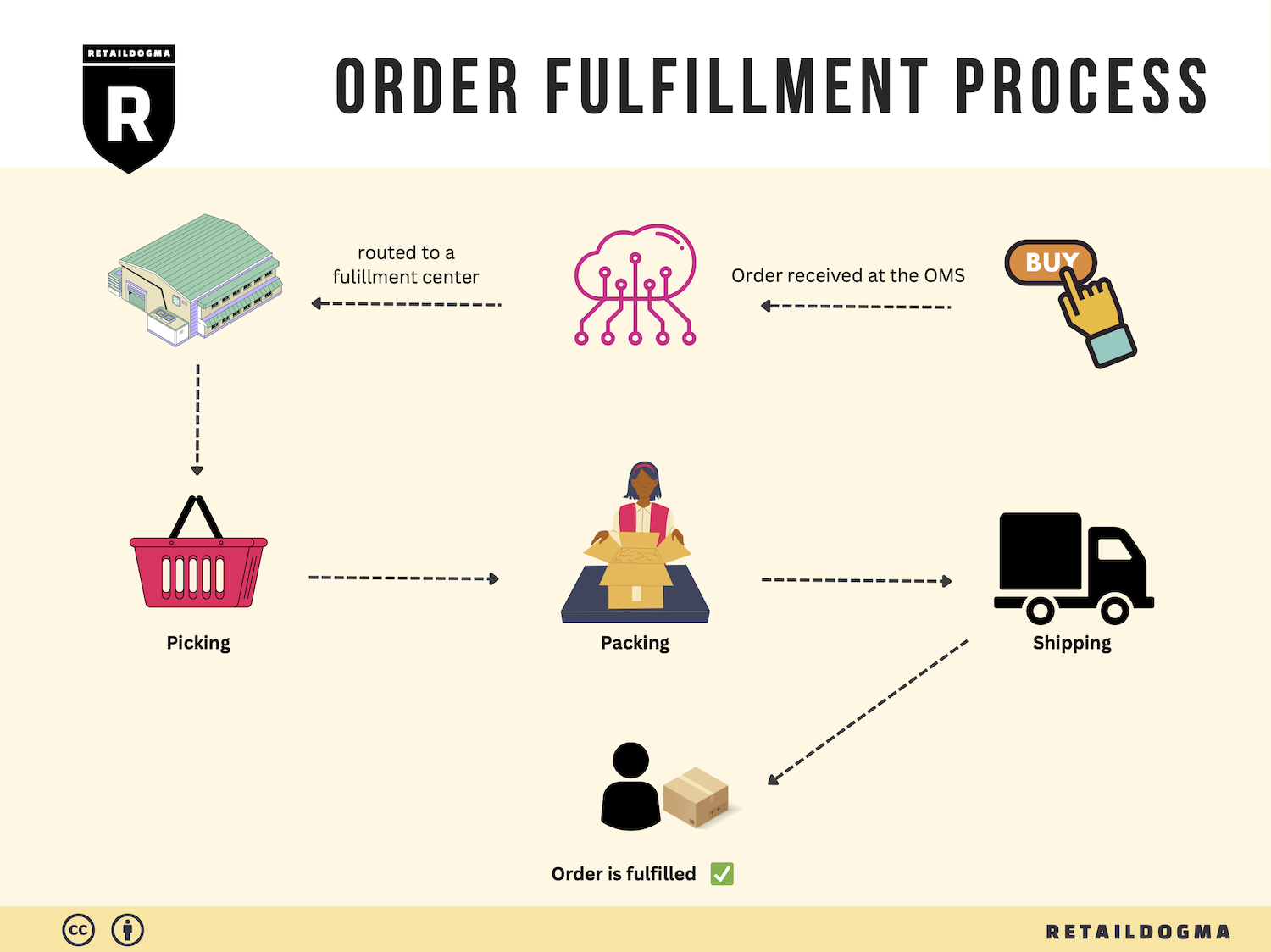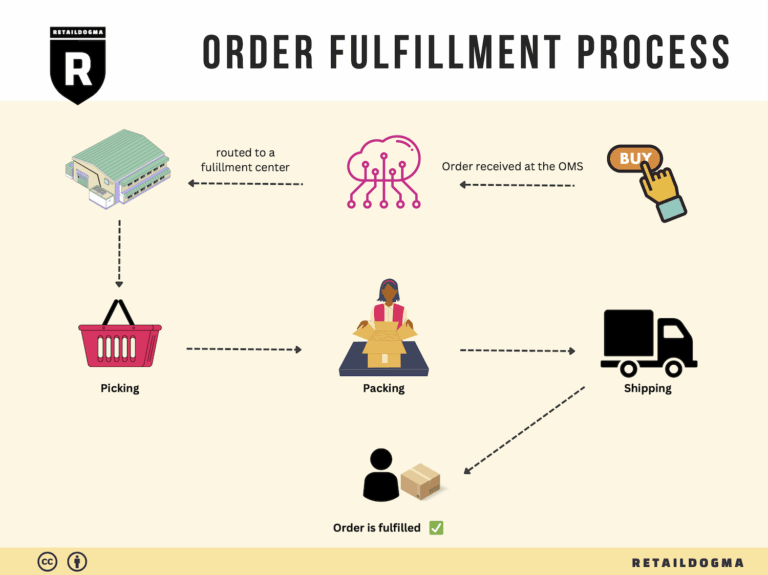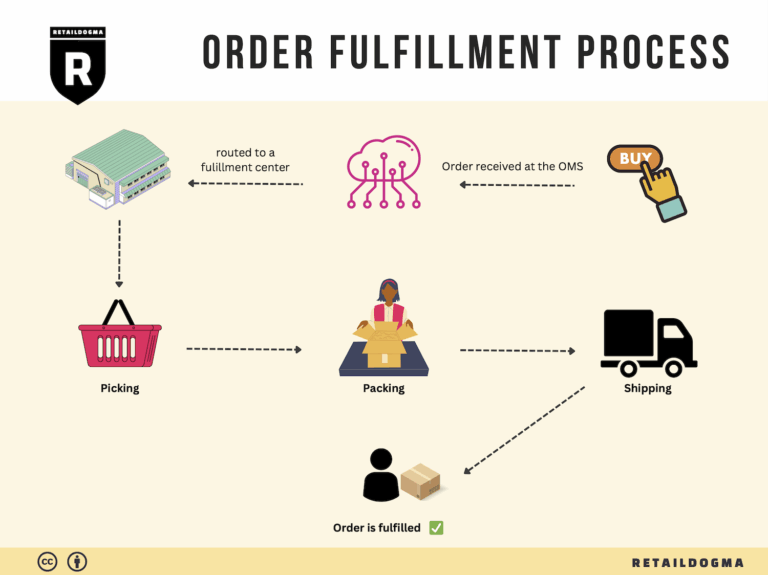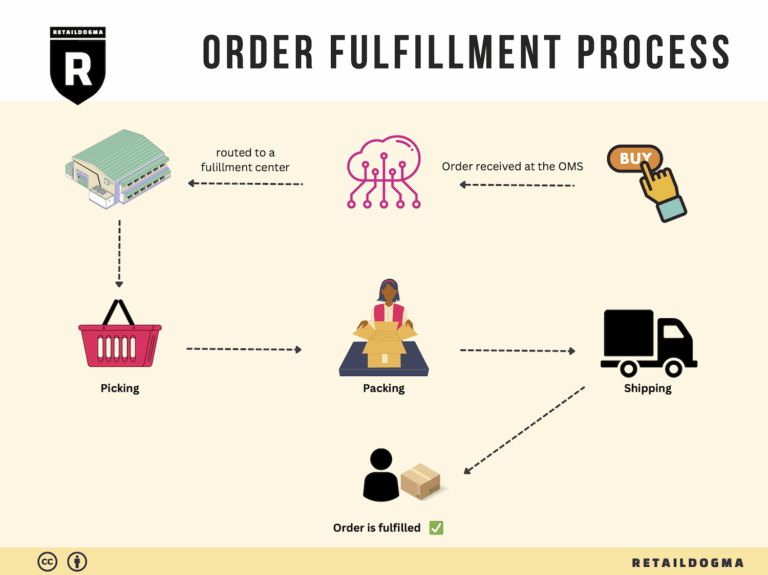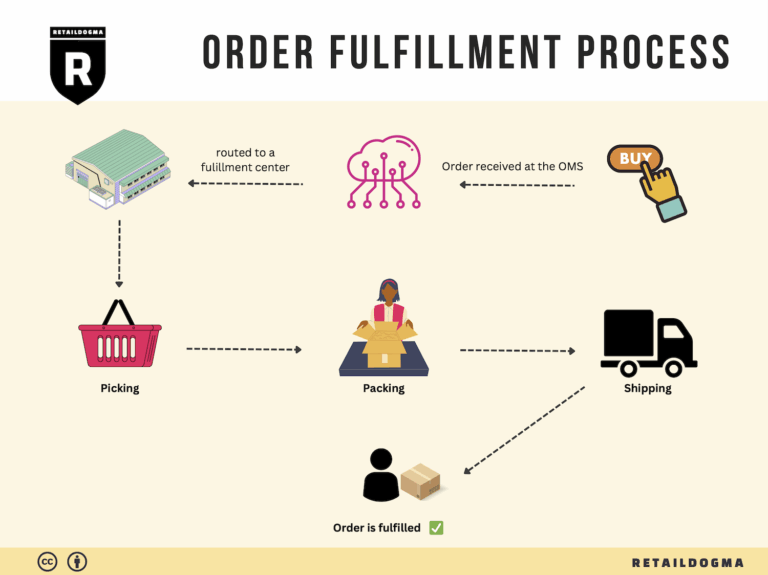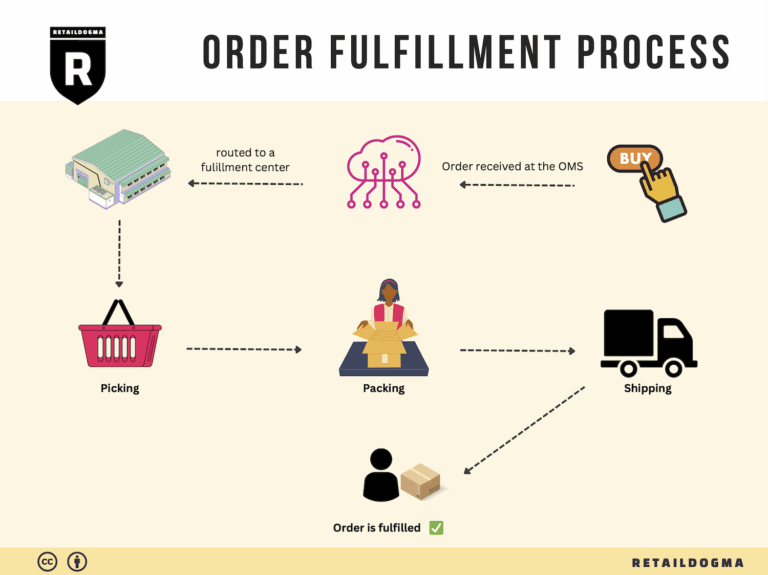How Order Fulfillment Works: A Step-by-Step Guide for Businesses
What is E-commerce Fulfillment? An Introduction for Growing Businesses
Understanding the Challenges of E-commerce Fulfillment
As an e-commerce business owner, you may find yourself grappling with the overwhelming task of packing and shipping orders. With growth comes complexity; the more orders you receive, the more time-consuming the logistics become. This often leads to late shipments, increased costs, and unhappy customers. The good news is that e-commerce fulfillment can streamline this process, allowing you to focus on what matters most: growing your business.
Defining E-commerce Fulfillment
At its core, fulfillment is the process of getting a product from your warehouse or fulfillment center to your customer’s doorstep. This involves several critical steps, including inventory management, order processing, packing, shipping, and handling returns. Understanding this process is essential for any growing business looking to enhance its logistics and improve customer satisfaction.
What This Guide Will Cover
This guide aims to demystify e-commerce fulfillment by exploring various fulfillment models, such as Third-Party Logistics (3PL) and Fulfillment by Amazon (FBA). We will delve into the core services offered by fulfillment partners, including inventory storage, order processing, and shipping solutions.
Choosing the right fulfillment partner is crucial for your business’s success. We’ll provide practical tips on how to assess potential partners based on factors like technology integration, scalability, and customer service. Additionally, we’ll discuss pricing structures, helping you understand the costs associated with different fulfillment options and how they can impact your bottom line.
Empowering Your Business Decisions
The ultimate goal of this guide is to empower you with the knowledge and tools necessary to make informed decisions about your logistics strategy. By understanding the nuances of e-commerce fulfillment, you can optimize your operations, reduce costs, and enhance customer experience. Whether you are considering outsourcing your fulfillment or seeking to refine your existing processes, this guide will serve as a valuable resource in navigating the complexities of e-commerce logistics.
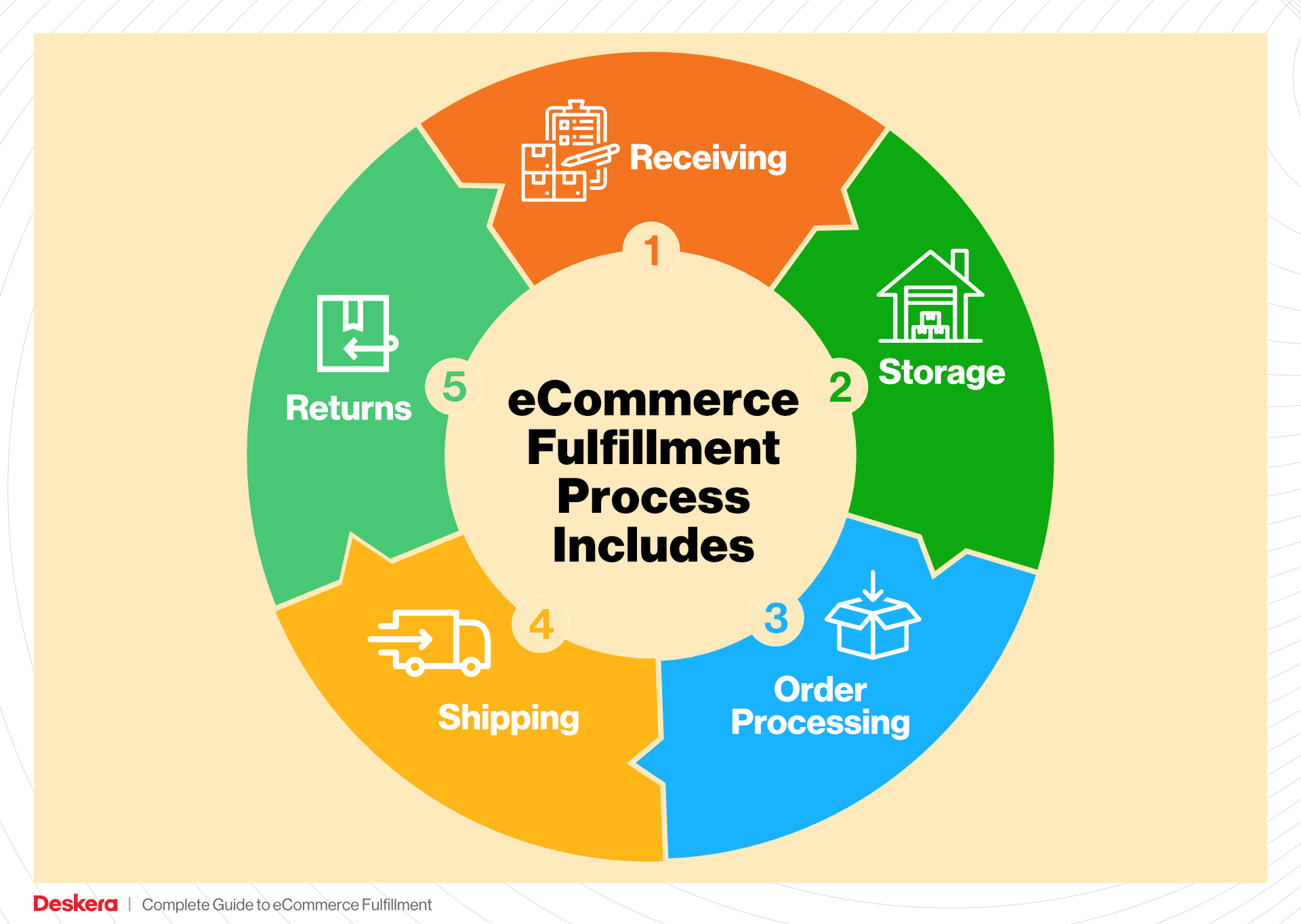
Prepare to take your fulfillment strategy to the next level and ensure that your growing business can meet customer demands effectively and efficiently.
What You’ll Learn In This Guide
- What is E-commerce Fulfillment? An Introduction for Growing Businesses
- The Order Fulfillment Process: From ‘Buy’ Button to Customer’s Door
- Comparing Fulfillment Models: In-House vs. 3PL vs. Dropshipping
- A Deep Dive into Amazon FBA: Pros, Cons, and Who It’s For
- Core Services Offered by Fulfillment Centers
- How to Choose a Fulfillment Partner: A 6-Point Checklist
- Understanding Fulfillment Pricing: A Breakdown of Common Fees
- Frequently Asked Questions (FAQs) about Fulfillment
- Conclusion: Is Outsourcing Fulfillment the Right Move for Your Business?
- Important Disclaimer
The Order Fulfillment Process: From ‘Buy’ Button to Customer’s Door
1. Receiving Inventory
The order fulfillment process begins with receiving inventory at the fulfillment center. This step involves checking incoming shipments against purchase orders to ensure accuracy in quantity and quality. Each product is assigned a unique SKU (Stock Keeping Unit), which allows for efficient tracking throughout the supply chain.
Why is this important? Receiving inventory accurately is crucial for maintaining stock levels and ensuring that the right products are available for customers. Errors at this stage can lead to stockouts or overstocking, both of which can negatively impact sales and customer satisfaction. Implementing a robust receiving process that incorporates technology—such as barcode scanners—can greatly enhance accuracy and speed.
2. Warehouse Storage
Once the inventory is received and verified, it moves into warehouse storage. Products are organized systematically, often using a combination of categorization and FIFO (First In, First Out) principles to manage stock rotation. This organization not only makes it easier to locate items but also helps in managing expiration dates for perishable goods.
The significance of effective warehouse storage cannot be overstated. A well-organized warehouse minimizes the time employees spend locating products, thus reducing overall operational costs. Additionally, it enhances inventory management, allowing businesses to maintain optimal stock levels. Using inventory management software can streamline this process by providing real-time data on stock levels and locations.
3. Order Picking
The next step is order picking, where items are selected from the warehouse to fulfill customer orders. This process can utilize various methods, including pick lists, which outline the items and quantities needed for each order. In automated systems, technology such as robotic pickers or automated guided vehicles (AGVs) may assist in this process.
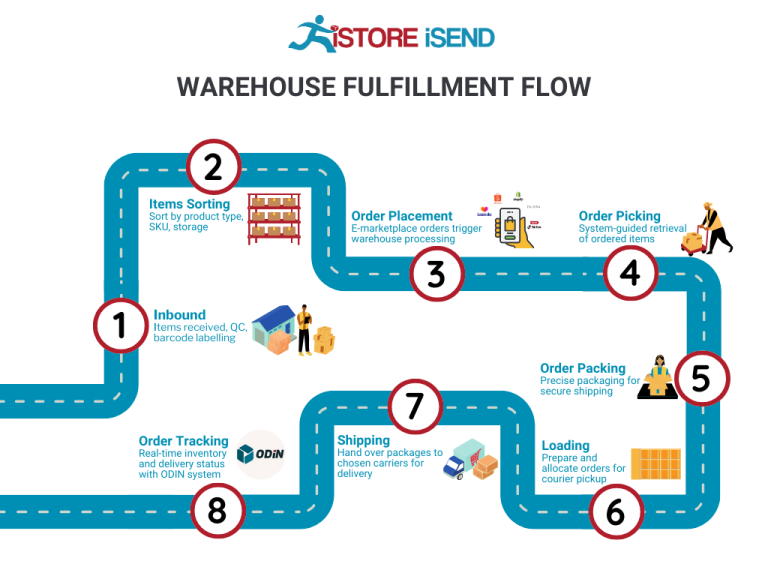
Order picking is critical because it directly impacts order accuracy and speed. Inefficient picking processes can lead to delays and errors, resulting in dissatisfied customers. To optimize picking efficiency, many businesses implement strategies like batch picking or zone picking, which can streamline workflows and reduce labor costs.
4. Order Packing
After items are picked, they move to the order packing stage. Here, products are carefully packed into boxes or containers, often using packing slips that confirm the contents of the package. This step may also involve the use of protective materials to ensure items arrive at their destination in perfect condition.
Packing is vital as it not only protects products during transit but also enhances the overall customer experience. A well-packed order reflects a company’s attention to detail and commitment to quality. Moreover, implementing sustainable packing materials can appeal to environmentally-conscious consumers, aligning with current market trends. Businesses should also consider utilizing packing automation technologies to improve speed and reduce labor costs.
5. Shipping & Delivery
The final step in the order fulfillment process is shipping and delivery. Once packed, orders are labeled and prepared for shipment through various carriers. Businesses often track shipments using tracking numbers, which allow customers to monitor their orders in real-time.
The importance of efficient shipping and delivery cannot be overstated, as it is often the last interaction a customer has with a brand. Timely delivery enhances customer satisfaction and loyalty, while delays can lead to negative reviews and lost sales. Businesses should explore partnerships with reliable shipping carriers, as well as consider options like same-day or next-day delivery to meet growing consumer expectations. Leveraging technology for route optimization can also help reduce shipping costs and improve delivery times.
By understanding and optimizing each step of the order fulfillment process, e-commerce businesses can enhance operational efficiency, reduce costs, and ultimately deliver a superior customer experience. This not only drives customer satisfaction but also positions the business for sustainable growth in an increasingly competitive market.
Comparing Fulfillment Models: In-House vs. 3PL vs. Dropshipping
Fulfillment Model Comparison
| Model | Who Handles Inventory | Best For (Business Stage) | Key Advantage | Key Disadvantage |
|---|---|---|---|---|
| In-House Fulfillment | The business itself | Established businesses | Greater control over inventory and processes | High overhead costs and resource-intensive |
| Third-Party Logistics (3PL) | A third-party provider | Startups and growing businesses | Flexibility and scalability | Less control over inventory and processes |
| Dropshipping | Supplier or manufacturer | New businesses or niche markets | Low startup costs and minimal risk | Lower profit margins and potential quality issues |
In-House Fulfillment
In-house fulfillment involves a business managing its own inventory, storage, and shipping processes. This model is often adopted by established companies that have the resources to maintain their own warehouses and logistics operations. The primary advantage of in-house fulfillment is the level of control it offers. Businesses can oversee every aspect of their supply chain, from inventory management to order processing and shipping. This control can lead to improved customer service, as businesses can respond quickly to issues and ensure that product quality meets their standards. However, this model comes with significant overhead costs, including labor, warehousing, and equipment. Additionally, managing fulfillment in-house can be resource-intensive, requiring a dedicated team and substantial investment in technology and infrastructure. As a result, while in-house fulfillment can be beneficial for larger, established businesses, it may not be feasible for startups or those looking to scale quickly.
Third-Party Logistics (3PL)
Third-party logistics (3PL) involves outsourcing fulfillment and logistics operations to a specialized provider. This model is particularly advantageous for startups and growing businesses that may not yet have the resources or infrastructure to manage fulfillment in-house. 3PL providers handle everything from inventory storage to order fulfillment and shipping, allowing businesses to focus on core activities such as marketing and product development. One of the key advantages of using a 3PL is the flexibility it offers; businesses can easily scale their operations up or down based on demand without incurring the fixed costs associated with in-house fulfillment. Additionally, 3PL providers often have established relationships with carriers, which can lead to reduced shipping costs and improved delivery times. However, a potential disadvantage is the loss of control over inventory management and fulfillment processes, which can impact customer service if the 3PL does not meet expectations. Businesses must carefully select a reputable 3PL partner to mitigate these risks.
Dropshipping
Dropshipping is a fulfillment model where the retailer does not keep products in stock but instead transfers customer orders and shipment details directly to the supplier or manufacturer, who then ships the products directly to the customer. This model is particularly appealing to new businesses or those entering niche markets due to its low startup costs and minimal risk. Since there is no need to invest in inventory upfront, businesses can test new products without significant financial commitment. Additionally, dropshipping allows for a wide range of products to be offered without the constraints of physical storage space. However, the dropshipping model also comes with its challenges. Profit margins can be lower compared to other fulfillment methods, as retailers typically pay a wholesale price that allows for minimal markup. Furthermore, quality control can be an issue, as businesses rely on suppliers to fulfill orders accurately and timely. Delays or errors in shipping can lead to negative customer experiences, which can be detrimental to a new brand. Overall, while dropshipping can be an effective way to enter the market, businesses must weigh these trade-offs carefully.
Conclusion
When deciding on a fulfillment model, e-commerce business owners and operations managers must consider their specific needs, resources, and growth strategies. In-house fulfillment offers control and potentially better customer service but at higher operational costs. Third-party logistics provides flexibility and scalability, making it suitable for growing businesses, while dropshipping offers a low-risk entry point for new ventures but may compromise profit margins and quality control. Each model has its unique advantages and disadvantages, and the right choice will depend on the specific context and goals of the business.
A Deep Dive into Amazon FBA: Pros, Cons, and Who It’s For
Understanding Fulfillment by Amazon (FBA)
Fulfillment by Amazon (FBA) is a service provided by Amazon that allows sellers to store their products in Amazon’s fulfillment centers. When a customer orders a product, Amazon takes care of storage, packaging, shipping, and customer service on behalf of the seller. This service can significantly simplify the logistics and operational aspects of selling products online.
How FBA Works
-
Setting Up Your Account: Sellers first need to create an Amazon seller account and enroll in the FBA program. This involves selecting the products they want to sell and configuring their settings.
-
Shipping Products to Amazon: Once enrolled, sellers must send their inventory to Amazon’s fulfillment centers. Amazon provides guidelines on how to package and label the products to ensure they are processed efficiently.
-
Storage and Inventory Management: After the products arrive at Amazon’s warehouses, they are stored until sold. Amazon tracks the inventory levels, and sellers can monitor their stock through the Amazon Seller Central dashboard.
-
Order Processing: When a customer places an order for a product, Amazon handles the entire fulfillment process. This includes picking the product from the shelves, packing it, and shipping it directly to the customer.
-
Customer Service and Returns: Amazon also manages customer service inquiries and returns, which can save sellers a significant amount of time and effort.
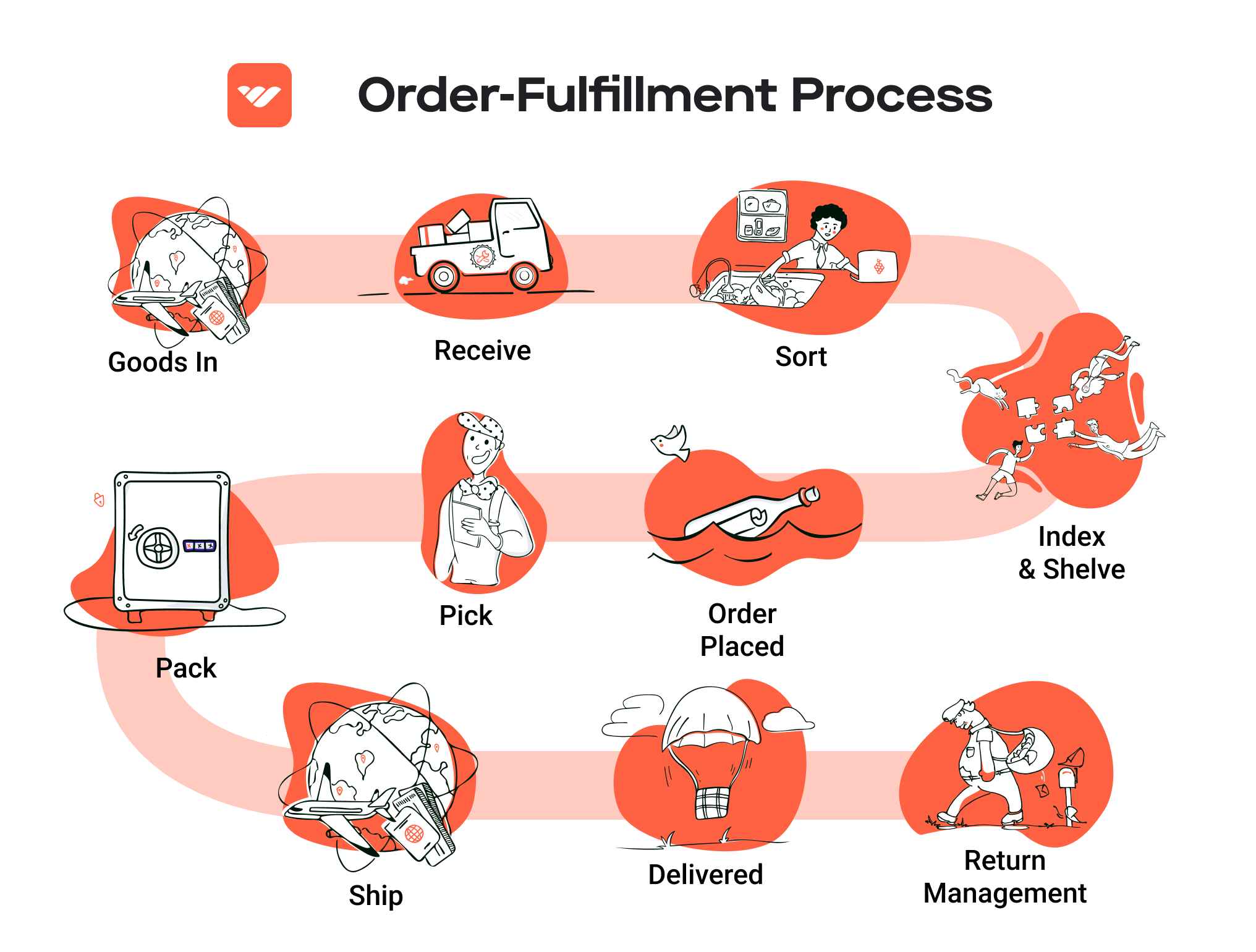
Pros of Using FBA
1. Prime Eligibility
One of the most significant advantages of FBA is that products fulfilled by Amazon are eligible for Amazon Prime. This means they can benefit from the vast Prime customer base who are often more willing to purchase items that offer fast, free shipping. Increased visibility and sales potential are significant draws for sellers.
2. Customer Trust
Amazon is a trusted brand, and customers often feel more comfortable purchasing items that are fulfilled by Amazon. This trust can lead to higher conversion rates for sellers, as buyers may prioritize FBA products over non-FBA alternatives.
3. Multi-Channel Fulfillment
FBA allows sellers to fulfill orders from other sales channels, not just Amazon. This means that if a seller has a website or sells on other platforms, they can still utilize Amazon’s fulfillment network to manage those orders, simplifying logistics and inventory management.
4. Streamlined Operations
By outsourcing storage, packing, and shipping to Amazon, sellers can focus more on growing their business rather than managing logistics. This allows for scalability and efficiency, especially for small to medium-sized businesses.
Cons of Using FBA
1. High Fees
While FBA offers many advantages, it also comes with significant costs. Sellers are charged storage fees based on the amount of space their products occupy in Amazon’s warehouses, as well as fulfillment fees for each unit sold. These costs can quickly add up, particularly for low-margin products.
2. Strict Inventory Rules
Amazon has strict policies regarding inventory management. Sellers must adhere to guidelines for labeling, packaging, and shipping their products. Additionally, there are penalties for long-term storage of unsold inventory, which can affect cash flow and profitability.
3. Commingling Risks
FBA involves commingling inventory, meaning that the products from different sellers can be stored together. This can lead to issues if products are damaged or if there are quality concerns, as sellers may receive negative feedback for issues that are out of their control.
4. Loss of Control
When using FBA, sellers relinquish a degree of control over their inventory and shipping processes. This can be a concern for businesses that prioritize brand experience or have specific shipping and handling requirements.
Who is FBA Best For?
Fulfillment by Amazon is particularly well-suited for certain types of sellers:
-
Small to Medium-Sized Businesses: Companies looking to scale quickly without investing heavily in logistics infrastructure will find FBA appealing. It allows them to leverage Amazon’s vast fulfillment network without the overhead costs.
-
Products with High Turnover: Sellers with high-demand products that can benefit from Prime eligibility will see significant advantages in sales velocity and market reach.
-
E-commerce Entrepreneurs: Those new to e-commerce can benefit from FBA’s streamlined operations and customer service management, allowing them to focus on product sourcing and marketing.
-
Multi-Channel Sellers: Businesses that sell on multiple platforms can effectively manage their logistics through FBA, simplifying the fulfillment process across different sales channels.
Conclusion
Fulfillment by Amazon provides a robust platform for sellers looking to streamline their operations and tap into the vast Amazon marketplace. While it offers significant advantages such as Prime eligibility and reduced operational burdens, potential sellers should carefully consider the associated costs and risks. By understanding both the benefits and drawbacks, e-commerce businesses can make informed decisions about whether FBA is the right choice for their growth strategy.
Core Services Offered by Fulfillment Centers
Inventory Management & Warehousing
Inventory management and warehousing are fundamental components of fulfillment center operations. This service encompasses the storage, tracking, and oversight of products before they are shipped to customers. Fulfillment centers utilize advanced inventory management systems to monitor stock levels in real-time, ensuring that e-commerce businesses can efficiently manage their product offerings.
Benefits:
1. Real-Time Visibility: With sophisticated software, e-commerce businesses gain insights into inventory levels, helping to prevent stockouts or overstock situations. This visibility allows for better forecasting and demand planning.
2. Cost Efficiency: By leveraging the space and resources of a fulfillment center, businesses can reduce their overhead costs associated with maintaining their own warehouses. This can lead to significant savings on rent, utilities, and labor.
3. Scalability: As a business grows, fulfillment centers can easily adjust to increased inventory needs without the hassle of relocating or expanding physical space. This flexibility is crucial for businesses looking to scale operations without disruption.
Pick and Pack Services
Pick and pack services involve the process of selecting items from inventory and packaging them for shipment. This service is crucial for ensuring that customers receive the correct products in a timely manner. Fulfillment centers employ trained staff and automated systems to streamline this process, minimizing errors and enhancing efficiency.
Benefits:
1. Speed and Accuracy: Fulfillment centers can process orders rapidly, often within the same day, ensuring that customers receive their orders promptly. This efficiency is particularly important during peak shopping seasons or promotional events.
2. Error Reduction: Automation and trained personnel reduce the likelihood of picking errors, which can lead to customer dissatisfaction and increased return rates. Accurate order fulfillment fosters customer trust and loyalty.
3. Customized Packaging: Many fulfillment centers offer branding options for packaging, allowing businesses to create a memorable unboxing experience. This customization can enhance brand recognition and customer satisfaction.
Kitting and Assembly
Kitting and assembly services involve grouping various products together into a single package or preparing items for sale. This could include assembling product bundles, gift sets, or promotional kits. Fulfillment centers can handle these complex tasks efficiently, ensuring that products are ready for sale as soon as they leave the warehouse.
Benefits:
1. Enhanced Product Offerings: By creating bundles or kits, businesses can increase average order values and provide customers with convenient purchasing options. This strategy can also encourage customers to try new products.
2. Operational Efficiency: Fulfillment centers can perform kitting and assembly tasks more efficiently than e-commerce businesses operating independently. This allows businesses to focus on core activities such as marketing and customer service.
3. Adaptability to Market Trends: Kitting services enable businesses to quickly respond to market demands or seasonal trends by creating targeted promotional offers without needing significant lead time or investment in additional infrastructure.
Returns Management (Reverse Logistics)
Returns management, or reverse logistics, is a critical service offered by fulfillment centers, allowing businesses to handle product returns efficiently. This process includes receiving returned items, inspecting them, restocking, or processing them for disposal or recycling. Effective returns management is essential for maintaining customer satisfaction and managing inventory effectively.
Benefits:
1. Customer Satisfaction: A streamlined return process enhances the customer experience. When customers know they can return products easily, they are more likely to make purchases, knowing they have options if the product does not meet their expectations.
2. Cost Control: Fulfillment centers can minimize the costs associated with returns by efficiently processing and restocking items. This can help businesses recover lost revenue from returns and manage their inventory more effectively.
3. Data Insights: Returns management provides valuable insights into customer preferences and product performance. Analyzing return data can help businesses make informed decisions about product quality, inventory management, and future offerings.
In conclusion, partnering with a fulfillment center offers e-commerce businesses a range of essential services that facilitate growth, enhance operational efficiency, and improve customer satisfaction. By leveraging the capabilities of fulfillment centers, businesses can streamline their logistics processes, allowing them to focus on scaling their operations and delivering exceptional service to their customers.
How to Choose a Fulfillment Partner: A 6-Point Checklist
Location & Warehouse Network
Importance: The geographical placement of your fulfillment partner’s warehouses significantly impacts shipping times and costs. A strategically located partner can ensure quicker delivery to your customer base, which is crucial for maintaining customer satisfaction and loyalty.
Questions to Ask:
– Where are your fulfillment centers located? How do these locations align with my target market?
– What is the average shipping time from your warehouses to my customers?
– Can you provide flexibility in shipping options, such as same-day or next-day delivery?
Technology & Integrations
Importance: In the rapidly evolving e-commerce landscape, robust technology is essential for efficient order processing, inventory management, and real-time data sharing. Your fulfillment partner should offer seamless integrations with your existing e-commerce platforms (like Shopify, WooCommerce, etc.) and provide tools for tracking inventory and orders.
Questions to Ask:
– What technology platforms do you use for order management and inventory tracking?
– Can your systems integrate with my current e-commerce software? If so, what is the process?
– Do you offer real-time tracking for both my team and my customers? How is this information communicated?
Specializations (e.g., Cold Storage, Oversized Items)
Importance: Depending on your product range, you may require specialized services. For instance, if you sell perishable goods, your partner should have proper cold storage facilities. Similarly, if you handle oversized or fragile items, the fulfillment partner must have the capability to manage these effectively.
Questions to Ask:
– Do you have facilities that cater to my specific product needs (e.g., cold storage, oversized items)?
– What protocols do you have in place for handling sensitive products?
– Can you accommodate seasonal fluctuations in inventory levels for specialized items?
Scalability & Capacity
Importance: As your business grows, your fulfillment needs will evolve. Choosing a partner with scalable solutions ensures that they can accommodate increased order volumes without compromising service quality. A partner with a robust capacity can also manage seasonal spikes effectively.
Questions to Ask:
– How do you handle increased order volumes during peak seasons?
– What steps do you take to scale operations in line with client growth?
– Can you provide examples of how you’ve successfully managed scalability for other clients?
Pricing and Contracts
Importance: Understanding the pricing structure is crucial for budgeting and forecasting. Transparent pricing models help avoid unexpected costs down the line. Additionally, reviewing contract terms is vital to ensure they align with your business goals and provide the flexibility you need.
Questions to Ask:
– What is your pricing model? Are there any hidden fees (e.g., for storage, order processing, returns)?
– Can you provide a detailed breakdown of costs associated with your services?
– What are the terms of the contract? Is there a minimum commitment period, and how does it handle contract termination?
Customer Support & Reviews
Importance: Exceptional customer support is essential for addressing issues quickly and maintaining smooth operations. Additionally, researching reviews and testimonials can provide insights into the partner’s reliability and service quality.
Questions to Ask:
– What kind of customer support do you offer? Is it available 24/7, and through which channels (phone, email, chat)?
– Can you provide references or case studies from current or previous clients?
– How do you handle issues related to order fulfillment, such as delays or misdeliveries? What is the escalation process?
Conclusion
Choosing the right fulfillment partner is a critical decision that can significantly influence your e-commerce business’s success. By using this checklist, you can systematically evaluate potential partners based on their location, technology capabilities, specializations, scalability, pricing, and customer support. Taking the time to ask the right questions will help you find a fulfillment partner that aligns with your business objectives and enhances your operational efficiency.
Understanding Fulfillment Pricing: A Breakdown of Common Fees
Initial Setup Fees
When partnering with a fulfillment center, businesses often encounter initial setup fees. These fees cover the costs associated with onboarding your account, which may include integrating your e-commerce platform with the fulfillment center’s system, configuring inventory management, and setting up your shipping profiles. The pricing structure for initial setup fees can vary widely depending on the complexity of your operations and the fulfillment provider’s capabilities.
Typically, these fees are either a flat rate or based on the number of SKUs you plan to store and ship. For example, a fulfillment center may charge a one-time fee of $500 to $2,000, depending on the extent of the services required. It is important to clarify what these fees include to avoid unexpected costs down the line.
Receiving Fees
Receiving fees are charged when your products arrive at the fulfillment center. This fee compensates the facility for the labor and resources required to unload, inspect, and record incoming inventory. The calculation of receiving fees can be based on several factors, including the volume of goods received, the number of pallets, or the time taken for the receiving process.
For instance, a fulfillment center might charge $25 to $50 per pallet, or $0.50 to $1.00 per item, depending on the specifics of the shipment. It’s essential to provide accurate shipment details to the fulfillment center to ensure these fees are calculated correctly and to avoid additional charges for discrepancies.
Storage Fees (per pallet/bin)
Storage fees are incurred for the space your inventory occupies within the fulfillment center. These fees can be calculated on a monthly basis and are typically charged per pallet or per bin. The cost of storage can vary based on the location of the fulfillment center and the type of items being stored.
For example, a fulfillment center may charge $10 to $25 per pallet per month, or $0.50 to $2.00 per bin, depending on the dimensions and weight of the products. Many providers also offer tiered pricing based on the volume of goods stored, which can be beneficial for businesses looking to scale. To minimize storage costs, businesses should regularly monitor their inventory turnover and adjust their stock levels accordingly.
Pick & Pack Fees (per item/order)
Pick and pack fees are charged for the process of retrieving items from storage and preparing them for shipment. This fee usually includes the labor involved in picking items, packaging them, and labeling the shipments. Fulfillment centers may charge either a flat fee per order or a variable fee based on the number of items in an order.
For instance, a typical pick and pack fee might range from $1.00 to $3.00 per order, plus an additional $0.20 to $0.50 for each item picked. Understanding this fee structure is crucial, especially for businesses with a diverse product range or varying order sizes, as it can significantly impact overall fulfillment costs.
Shipping Fees
Shipping fees are perhaps the most variable component of fulfillment pricing, as they depend on the destination, weight, dimensions of the package, and the chosen shipping carrier. Fulfillment centers often negotiate rates with carriers, and these savings can be passed on to clients. However, businesses should be aware that different shipping methods (e.g., standard, expedited, overnight) will incur different costs.
To estimate shipping fees accurately, consider using the fulfillment center’s shipping calculators or requesting a quote based on your typical order profiles. It’s important to evaluate whether the fulfillment center offers access to discounted shipping rates, as this can lead to significant savings over time.
Tips for Getting an Accurate Quote
To ensure you receive an accurate quote from a fulfillment center, consider the following tips:
-
Provide Detailed Inventory Information: Include the number of SKUs, dimensions, and weights of your products. This helps the fulfillment center calculate storage and shipping fees accurately.
-
Discuss Your Order Volume: Be clear about your expected order volume and frequency. This information can influence pricing models and may qualify you for bulk discounts.
-
Inquire About Hidden Fees: Ask about any additional fees that may not be immediately apparent, such as returns processing or long-term storage fees.
-
Request a Trial Period: If possible, negotiate a trial period to evaluate the services and associated costs before committing long-term.
-
Compare Multiple Providers: Don’t settle for the first quote. Compare offers from multiple fulfillment centers to understand the range of services and pricing structures available.
By being proactive and thorough in your inquiries, you can ensure that you choose a fulfillment partner that aligns with your business needs while keeping costs manageable.
Frequently Asked Questions (FAQs) about Fulfillment
1. What is a fulfillment center?
A fulfillment center is a specialized warehouse that handles the storage, packing, and shipping of products for e-commerce businesses. Unlike traditional warehouses, fulfillment centers focus on order fulfillment and often incorporate advanced technology and automation to streamline operations, ensuring quick delivery to customers.
2. How does Chewy’s fulfillment center operate?
Chewy’s fulfillment centers operate using a blend of advanced automation and human labor to process orders efficiently. Products are stored in a systematic manner, and when an order is placed, automated systems help pick, pack, and ship the items quickly. This integration of technology enhances accuracy and reduces operational costs, allowing Chewy to maintain high customer satisfaction.
3. What is the difference between a warehouse and a fulfillment center?
While both warehouses and fulfillment centers are used for storage, the primary difference lies in their function. Warehouses are designed mainly for long-term storage of products, while fulfillment centers are equipped to handle order processing and shipping. Fulfillment centers focus on rapid order fulfillment and often include technology to automate these processes.
4. What is a 3PL (Third-Party Logistics) provider?
A 3PL is a service provider that manages logistics and fulfillment operations on behalf of businesses. This can include warehousing, inventory management, order fulfillment, and shipping. Partnering with a 3PL allows companies to scale their operations without investing in their own logistics infrastructure.
5. How much do fulfillment services cost?
Fulfillment service costs can vary based on several factors, including the volume of orders, storage space required, and the specific services needed (like packing and shipping). Generally, businesses can expect to pay a per-order fee, a monthly storage fee, and additional charges for special services. It’s essential to evaluate different providers to understand pricing structures and ensure they align with your budget.
6. What types of products can Chewy’s fulfillment center handle?
Chewy’s fulfillment centers specialize in pet-related products, including food, toys, treats, and medications. The centers are designed to accommodate a wide range of items, ensuring that pet parents receive their orders promptly and accurately.
7. How does Chewy ensure timely delivery during peak seasons?
Chewy employs a combination of advanced technology and strategic planning to manage order fulfillment during peak seasons. By leveraging automation and optimizing staffing levels, Chewy can efficiently handle increased order volumes, ensuring that customers receive their products on time, even during busy periods like holidays.
8. What role does automation play in Chewy’s fulfillment centers?
Automation plays a crucial role in enhancing the efficiency and accuracy of Chewy’s fulfillment operations. Currently, about 30% of Chewy’s distribution volume is processed through automated systems, with plans to increase this to over 70%. Automation helps reduce labor costs, speeds up order processing, and minimizes human error.
9. How can e-commerce businesses benefit from using a fulfillment center like Chewy’s?
Utilizing a fulfillment center like Chewy’s allows e-commerce businesses to focus on growth while outsourcing logistics. Benefits include reduced operational costs, access to advanced technology, improved order accuracy, and faster shipping times, all of which contribute to enhanced customer satisfaction and loyalty.
10. What should I consider when choosing a fulfillment center?
When selecting a fulfillment center, consider factors such as location, technology capabilities, pricing structure, scalability, and customer service. It’s also important to evaluate the fulfillment center’s experience in your specific industry to ensure they can meet your unique needs effectively.
Conclusion: Is Outsourcing Fulfillment the Right Move for Your Business?
Evaluating the Benefits of Outsourcing Fulfillment
As e-commerce continues to evolve, the decision to outsource fulfillment has become a strategic consideration for many businesses. Partnering with a fulfillment service can offer significant advantages that align with growth objectives.
Firstly, outsourcing fulfillment saves valuable time. By delegating logistics tasks such as inventory management, order processing, and shipping, business owners can focus on core activities such as marketing, product development, and customer engagement. This shift not only enhances productivity but also allows for more strategic allocation of resources.
Secondly, scalability is a critical benefit. Fulfillment centers, particularly those equipped with automation, can easily adapt to fluctuations in order volume. This flexibility is essential for businesses experiencing seasonal spikes or growth spurts, as they can scale operations without the need for significant capital investment in infrastructure or personnel. For example, Chewy’s advanced automated fulfillment centers enable rapid response to increased demand, ensuring timely deliveries that enhance customer satisfaction.
Moreover, leveraging the expertise of a fulfillment partner can elevate your logistics operations. These partners often have specialized knowledge and advanced technology that streamline processes, reduce costs, and improve accuracy. Their experience in managing supply chains can also mitigate risks associated with shipping delays and inventory shortages.
Choosing the Right Partner for Growth
However, the success of outsourcing fulfillment hinges on selecting the right partner. Conduct thorough due diligence to ensure alignment with your business values, operational needs, and customer expectations. An ideal partner should not only enhance your logistics capabilities but also contribute to your overall growth strategy.
Call to Action
To determine if outsourcing fulfillment is the right next step for your business, conduct an audit of your current shipping processes. Evaluate efficiency, costs, and customer satisfaction metrics. This analysis will provide insights into whether a fulfillment partner could help you streamline operations and support your scaling ambitions. Take the time to explore your options—your business’s future may depend on it.
Important Disclaimer
⚠️ Important Disclaimer
The information in this guide is for educational purposes. Fulfillment services, pricing, and platform features change frequently. Always conduct your own due diligence and consult with providers directly before making business decisions.
